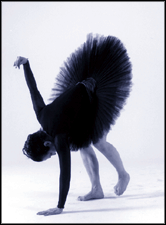June 15 - 22, 2000
![[Dance Reviews]](/standard/image/headers/dance_performance_header.gif)
| reviews & features | dance performance | dance participatory | hot links |
Dancelets
Anna Myer at Green Street
by Marcia B. Siegel
Anna Myer's concert at Green Street Studios last weekend looked like a collection of small ideas she got at different times and stuck into a file without a name. The ideas were parceled out into four different but almost interchangeable dances. Any one of the morsels could have been scooped out of one dance and inserted into another without a ripple. At least, it looked that way to me, partly because there was so much shared vocabulary among these works and they all used the same six dancers, with one or two add-ons or subtractions in each piece.

All the pieces were accompanied by musical selections, not complete, through-composed scores: operatic numbers for In Italian II, Vivaldi chamber music for In Italian I, miscellaneous pop and country songs for BlueBird No. 173, and, for the new work, Variations on the Theme, seven excerpts from Bach's The Art of the Fugue arranged for piano, violin, and cello by David Polan (violinist Karen Oosterbaan and cellist Sarah Shifferd playing live with Polan). This musical collage work encouraged a building-block dance form where one unit could follow another somewhat arbitrarily, rather than a progressive or sequential development of choreographic themes.
Myer works in a formal way, determined not to let stories or sentiment get the better of craft. She choreographs the music respectfully but not profoundly. Her movement material is quite limited: walking and standing still are the basic leggy instructions. There are some stag jumps; there's some swinging back to front, along with falling to the side or dropping into a sprint position. I notice the dancers when they're poised to go. Or just arriving somewhere, or holding in certain positions while others people do phrase bits. But the dance doesn't have a strong sense of traveling.
The dance's meaning, if there is any, comes from gestures interwoven through the changing floor patterns. Sometimes these are recognizable. Hands might be outstretched in prayer or supplication, crossed over the body to the opposite hip and shoulder, shooting imaginary bows and arrows. The dancers often work with partners, lying on the floor spoon fashion, or carry out mutual support actions of lifting, falling, catching, pulling up.
Although I can "read" all these signs, they don't resonate. They're abstract, not personal. One person can lie down with any other person; they can all shoot make-believe arrows. Nothing changes but the design. Yet some formalist choreographers, George Balanchine, for instance, can make abstract movement that's not only moving but ripe with suggestion. The three seated muses who lift one leg to touch the hand of Apollo (I saw the Massachusetts Youth Ballet give this work on Saturday night) seem to be making a cosmic connection -- with a gesture you could see someone do on a beach. How this can happen is a great mystery to me.
The one piece of Myer's with charm in addition to its structural neatness was BlueBird No. 173, which she made in 1997. Eight dancers begin the piece, led by Carol Somers. She initiates movement phrases and the others form a back-up chorus, imitating her or escorting her. Eventually, seven little girls join them, stepping in a waltz rhythm across the back of the space. The little girls are as calm as the dancers, going about their simple patterns, separating, running across to jump up and wrap their legs around their partners' waists, or seating themselves on the floor and leaning against the knees of their adult partners. This stuff can't miss, and the audience loves it.
Anna Myer's six or seven stalwarts contribute a variety of backgrounds and specialties, and I guess having a company of unhomogenized individuals is an article of postmodern faith. But the differences among them were so wide -- from Carol Somers's over-the-top emotionalism to Bess Rouse's almost closeted neutrality -- it seemed to me that they didn't always have a common idea about what they were doing.
Myer herself is a quick, clear dancer, alive to the performing moment and able to make sudden changes of focus and shape without fuzzy transitions. She's had a lot of ballet training and experience but, either from her own choice or from the shortsightedness of ballet directors, she choreographs in a pretty small sphere of challenges. Maybe the question of ballet repertory is another discussion, but professional ballet companies lose a lot in variety by not offering opportunities to those with obvious choreographic talents. Neither they nor the choreographers nor the audience can grow beyond a certain point if everybody is comfortable with what they can already do.
| home page | what's new | search | about the phoenix | feedback |
Copyright © 1999 The Phoenix Media/Communications Group. All rights reserved.
